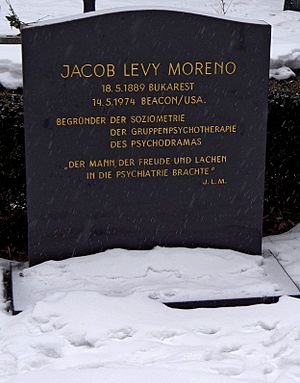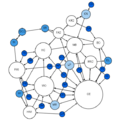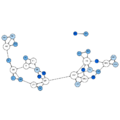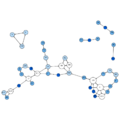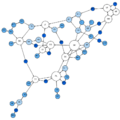Jacob L. Moreno facts for kids
Quick facts for kids
Jacob L. Moreno
|
|
|---|---|
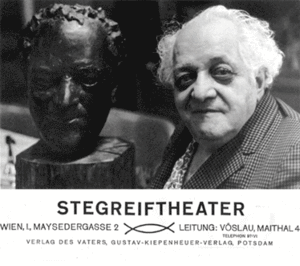 |
|
| Born |
Iacob Levy
May 18, 1889 Bucharest, Kingdom of Romania
|
| Died | May 14, 1974 (aged 84) Beacon, New York, U.S.
|
| Alma mater | University of Vienna |
| Known for | Sociometry, psychodrama |
| Spouse(s) | Beatrice Beecher, Florence Bridge, Zerka T. Moreno |
| Scientific career | |
| Fields | Psychiatry, psychology, psychotherapy, social psychology |
| Influenced | Kurt Lewin, Martin Buber, Fritz Perls |
Jacob Levy Moreno (born Iacob Levy; May 18, 1889 – May 14, 1974) was a doctor, social scientist, and teacher. He was born in Romania and later became an American citizen. He is famous for creating psychodrama and for being a leader in group psychotherapy. He was known as one of the most important social scientists of his time.
Contents
Early Life and Education
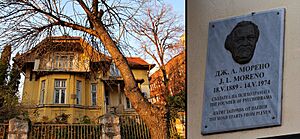
Jacob Levy Moreno was born in Bucharest, which was then part of the Kingdom of Romania. His father, Moreno Nissim Levy, was a merchant from a Sephardi Jewish family. Sephardi Jews are a group of Jewish people who originally lived in Spain and Portugal.
His family moved to Vienna, Austria, in 1895. This was a time of many new ideas and political changes. Jacob studied medicine, math, and philosophy at the University of Vienna. He became a medical doctor in 1917.
Even as a student, he didn't agree with the ideas of Sigmund Freud, another famous doctor. Moreno was more interested in how groups of people could help each other in therapy.
Moreno once shared a story about meeting Freud in 1912. Freud asked him what he did. Moreno replied, "I start where you leave off. You meet people in your office. I meet them in their homes, in their natural places."
He added, "You analyze their dreams. I help them have the courage to dream again. You take them apart. I help them act out their problems and put themselves back together."
Family Life
Moreno married Beatrice Beecher in New York in 1926, but they later divorced. In 1938, he married Florence Bridge, and they had a daughter named Regina Moreno. They also divorced.
In 1949, he married Zerka Toeman. They had a son named Jonathan D. Moreno.
Moreno's Career and Ideas
When Moreno lived in Vienna, he started an acting group called Stegreiftheater, or the Theater of Spontaneity. Here, he developed a type of therapy called psychodrama. This method used acting, role-playing, and other spontaneous dramatic activities.
Moreno believed that psychodrama helped people be more creative and spontaneous. It allowed them to act out their problems instead of just talking about them. They could even pretend to be important people in their lives to understand them better.
In 1925, Moreno moved to the United States and settled in New York City. He continued to work on his ideas about how people relate to each other. He developed psychodrama, sociometry, group psychotherapy, sociodrama, and sociatry.
He felt that New York was the perfect place for his work. He wrote that it was "the melting pot of the nations," where he could freely explore his ideas about groups.
The New York Times newspaper noted that some people were slow to accept his ideas. This was partly because some other doctors thought he was too much of a "showman."
Moreno worked at different places, including Mount Sinai Hospital. In 1929, he started an Impromptu Theater at Carnegie Hall. He also studied how groups worked at Sing Sing Prison in 1931.
In 1932, Moreno introduced group psychotherapy to the American Psychiatric Association. He also wrote a book with Helen Hall Jennings about group methods. They were among the first to use a "chance sociogram," which is a way to map out connections between people.
In 1936, he opened the Beacon Hill Sanitarium and a special Therapeutic Theater next to it. He also taught about psychodrama at Columbia University.
For the next 40 years, he kept developing his ideas about how people interact. He created tools for social science like 'sociodrama,' 'psychodrama,' 'sociometry,' and 'sociatry.' He believed these sciences could help balance the focus on money, individual psychology, and technology in the world.
In his autobiography, Moreno explained his main beliefs:
- Being spontaneous and creative helps people make progress. These qualities are important on their own, not just because of other reasons like money or personal desires.
- Love and sharing are very strong and necessary for groups to work well. We need to trust each other's intentions, more than just obeying rules.
- A strong community based on these ideas can be built using new methods.
Moreno passed away at his home in Beacon, New York, in 1974, at the age of 84. He chose to stop eating and drinking after a long illness. His ashes are buried in Vienna. On his grave, it says: "THE MAN WHO BROUGHT JOY AND LAUGHTER TO PSYCHIATRY."
Moreno's Important Contributions
Moreno's methods have remained respected over time. Research from the University of Vienna shows how much his idea of the "Encounter" influenced Martin Buber's "I-Thou" philosophy. Buber's ideas then influenced many areas like philosophy and psychology.
Moreno's wife, Zerka Moreno, said that while Buber expanded the idea of the Encounter, Moreno created the tools to make it happen. These tools include sociometry, group psychotherapy, psychodrama, and sociodrama. Zerka herself was an expert and continued her husband's work after he died.
Today, there are training centers and institutes for Moreno's work all over the world. Many students are learning and teaching his methods. They are helping to make these social sciences available to everyone.
Moreno is also seen as one of the founders of social network analysis. This is a part of sociology that studies how people are connected in groups. It looks at an individual's role by mapping out their connections to others.
His 1934 book, Who Shall Survive?, has some of the first pictures of social networks, called sociograms. In this book, he explained why many girls ran away from the New York Training School for Girls in Hudson.
- Sociograms
Books by J. L. Moreno
- Moreno, J. L. (1932). First Book on Group Therapy.
- Moreno, J. L. (1934). Who Shall Survive? A new Approach to the Problem of Human Interrelations.
- Moreno, J. L. (1941). The Words of the Father.
- Moreno, J. L. (1946). Psychodrama Volume 1.
- Moreno, J. L. (1947). The Theatre of Spontaneity.
- Moreno, J. L. (1951). Sociometry, Experimental Method and the Science of Society: An Approach to a New Political Orientation.
- Moreno, J. L. (1953). Who Shall Survive? Foundations of Sociometry, Group Psychotherapy and Sociodrama.
- Moreno, J. L. (1956). Sociometry and the Science of Man.
- Moreno, J. L. (1959). Psychodrama Volume 2: Foundations of Psychodrama.
- Moreno, J. L. (1960). The Sociometry Reader.
- Moreno, J. L., Moreno, Z. T., Moreno, J. D. (1964). The First Psychodramatic Family.
- Moreno, J. L. (1966). The International Handbook of Group Psychotherapy.
- Moreno, J. L. (1969). Psychodrama Volume 3: Action Therapy and Principles of Practice.
- Moreno, J. L. (1989). Preludes of my Autobiography.
See also
 In Spanish: Jacob Levy Moreno para niños
In Spanish: Jacob Levy Moreno para niños


